
05.10.2025
10 Ruby Gems für schnellere Entwicklung

Dariusz Michalski
CEO
Entdecken Sie 10 unverzichtbare Ruby-Gems, die die Entwicklungszeit und -qualität verbessern und Aufgaben wie Debugging, Authentifizierung und Dateiuploads effizient angehen.
Ruby-Entwickler verlassen sich auf Gems, um Zeit zu sparen und Arbeitsabläufe zu vereinfachen, insbesondere beim Erstellen komplexer Anwendungen. Hier sind 10 essentielle Ruby-Gems, die die Entwicklung beschleunigen und gleichzeitig qualitativ hochwertige Ergebnisse gewährleisten. Diese Werkzeuge übernehmen Aufgaben wie Debugging, Authentifizierung, Testing und Dateiuploads, sodass Sie sich auf das Erstellen von Funktionen und nicht auf sich wiederholendes Kodieren konzentrieren können.
Wichtige Gems und ihre Anwendungsfälle:
Pry: Fortgeschrittenes Debugging mit Live-Code-Bearbeitung und Laufzeitinspektion.
Devise: Vereinfacht die Benutzer-Authentifizierung mit vorgefertigten Abläufen und sicheren Standardeinstellungen.
RSpec: Verhaltensgesteuertes Testing mit klarer Syntax und wiederverwendbaren Teststrukturen.
RuboCop: Durchsetzung von Code-Stilen und Qualität mit automatisierten Checks und Fixes.
FactoryBot: Vereinfacht das Setup von Testdaten mit dynamischen, wiederverwendbaren Fabriken.
Sidekiq: Effiziente Verarbeitung von Hintergrundjobs mit Redis.
Kaminari: Handhabung von Pagination für große Datensätze mit minimalem Setup.
ActiveAdmin: Generiert Admin-Dashboards und Tools mit minimalem Aufwand.
CarrierWave: Verwaltet Dateiuploads, einschließlich Bildverarbeitung und Cloud-Speicherung.
Rdkafka: Integriert Apache Kafka für Hochleistungsdaten-Streaming.
Warum diese Gems wichtig sind:
Zeit sparen: Automatisieren Sie sich wiederholende Aufgaben wie Debugging, Testing und Datenmanagement.
Qualität verbessern: Stellen Sie konsistente Codestandards und zuverlässige Arbeitsabläufe sicher.
Komplexität handhaben: Effiziente Verwaltung von Hintergrundjobs, Dateiuploads und großen Datensätzen.
Bereit für Lokalisierung: Viele dieser Gems unterstützen mehrsprachige Schnittstellen und schweizerische Anforderungen wie CHF-Formatierung und CET/CEST-Zeitzonen.
Diese Gems sind entscheidend für Entwickler, die skalierbare, wartbare Anwendungen erstellen möchten, während sie die Entwicklungszeit reduzieren. Egal, ob Sie mit Pry debuggen, mit RSpec testen oder Jobs mit Sidekiq verwalten, diese Werkzeuge bieten praktische Lösungen für häufige Herausforderungen.
Top 10 Must-Know Ruby on Rails Gems für Entwickler🚀| #RailsGems #RubyOnRails #DevTips #RubyGems #ROR

1. Pry
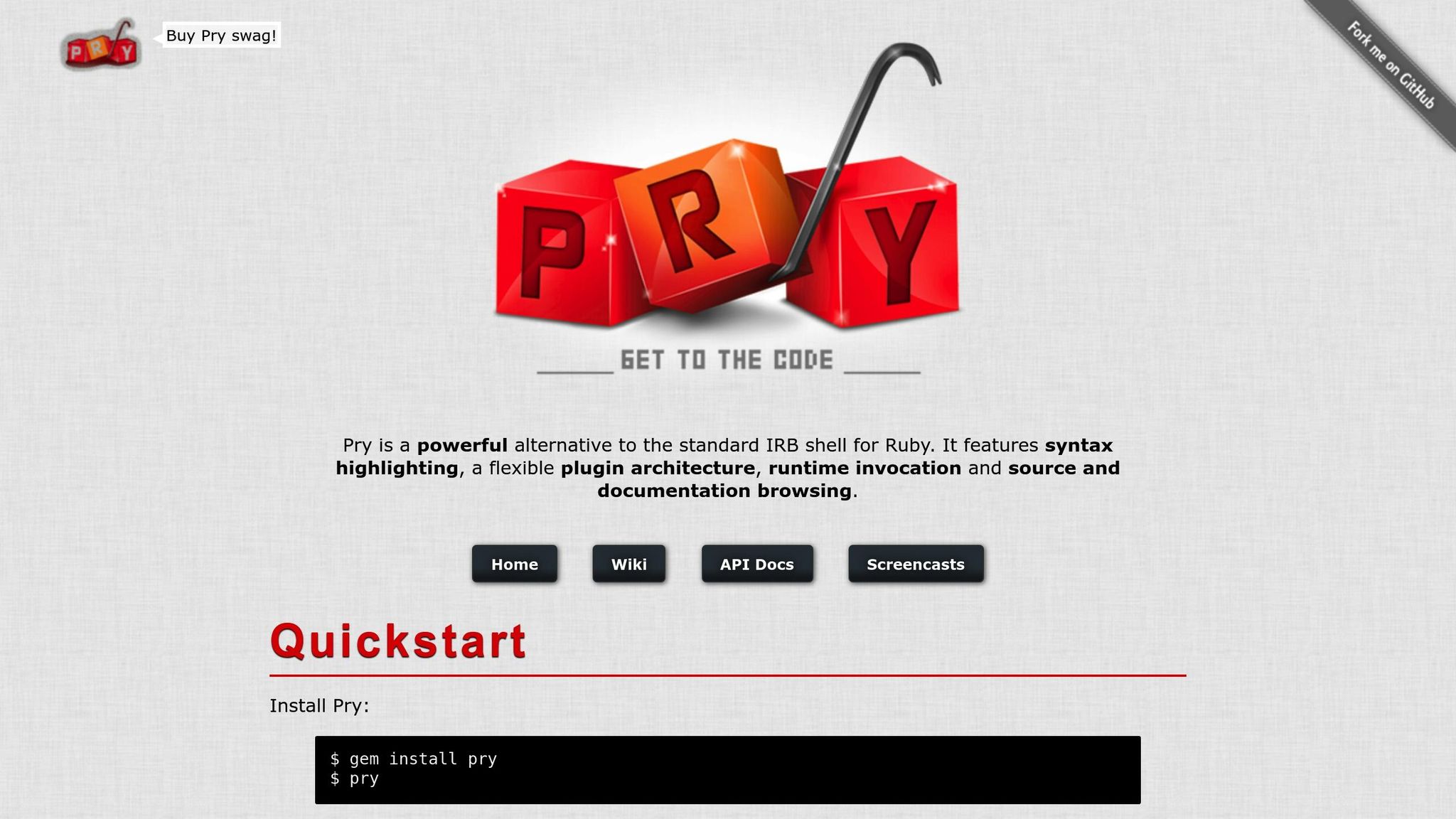
Pry bringt Ruby-Debugging auf ein ganz neues Level, indem es eine interaktive und dynamische Umgebung bietet. Es ersetzt die Standard-IRB-Konsole und ermöglicht Entwicklern, die Codeausführung jederzeit anzuhalten, um den Status der Anwendung in Echtzeit zu inspizieren und zu manipulieren.
Funktionen, die Zeit während der Entwicklung sparen
Eine der herausragenden Funktionen von Pry ist die Live-Code-Bearbeitung. Damit können Sie Variablen anpassen, alternative Code-Pfade testen und sogar Methoden spontan umdefinieren - alles ohne die Anwendung neu zu starten. Es beseitigt den sich wiederholenden Zyklus, Print-Statements hinzuzufügen, Server neu zu starten und Fehler zu reproduzieren, wodurch das Debugging wesentlich effizienter wird.
Weitere nützliche Funktionen sind Syntaktische Hervorhebung und Autocomplete, die das Navigieren durch komplexe Codebasen vereinfachen. Mit einfachen Befehlen wie ls können Sie verfügbare Methoden auflisten, während cd es Ihnen ermöglicht, in bestimmte Objekte hinein zu navigieren. Der Befehl show-source ist ein weiteres Highlight, das sofort die Methodendefinitionen offenbart, ohne dass Sie durch Dateien graben müssen.
Pry bietet auch eine Historienverwaltung, die ein Protokoll Ihrer Debugging-Sitzungen führt. Befehle wie hist --grep erleichtern das Durchsuchen vergangener Sitzungen und helfen Ihnen, effektive Debugging-Techniken wiederzuerlangen - selbst von vor Monaten.
Nahtlose Integration mit Ruby on Rails
Für Rails-Entwickler arbeitet Pry nahtlos über das Pry-Rails-Gem. Wenn es mit pry-byebug kombiniert wird, ermöglicht es schrittweises Debugging für Controller und Modelle. Ihre rails console erhält ein großes Upgrade, das standardmäßig mit den erweiterten Funktionen von Pry gestartet wird.
Pry verbessert zudem das ActiveRecord-Debugging. Es formatiert Datenbankabfragen klar und lesbar und beinhaltet Ausführungszeiten, sodass Sie Leistungsprobleme erkennen können, ohne zwischen Protokolldateien und Ihrem Debugger hin und her springen zu müssen.
Aber Pry dient nicht nur dem Debugging - es verbessert auch die Programmierpraktiken und optimiert die Arbeitsabläufe.
Verbesserung der Codequalität und Arbeitsabläufe
Pry fördert Echtzeittest und macht mit Plugins wie pry-doc und pry-stack_explorer die Dokumentation in der Konsole und die Navigation durch den Call-Stack zum Kinderspiel.
Sein anpassbarer Prompt ist ein weiterer Game-Changer. Sie können ihn so einrichten, dass wichtige kontextuelle Informationen wie der aktuelle Git-Zweig, die Rails-Umgebung oder der Status der Datenbankverbindung angezeigt werden. Dies reduziert Kontextwechsel und hilft, kritische Fehler zu vermeiden, wie das Ausführen destruktiver Befehle in der Produktion.
Zu guter Letzt ermöglicht Pry's Befehlsaliasierung den Teams, benutzerdefinierte Befehle zu erstellen, die mehrere Pry-Operationen bündeln. Dadurch wird ein konsistenter Debugging-Ansatz innerhalb Ihres Teams sichergestellt, was die Zusammenarbeit reibungsloser und effizienter macht.
2. Devise
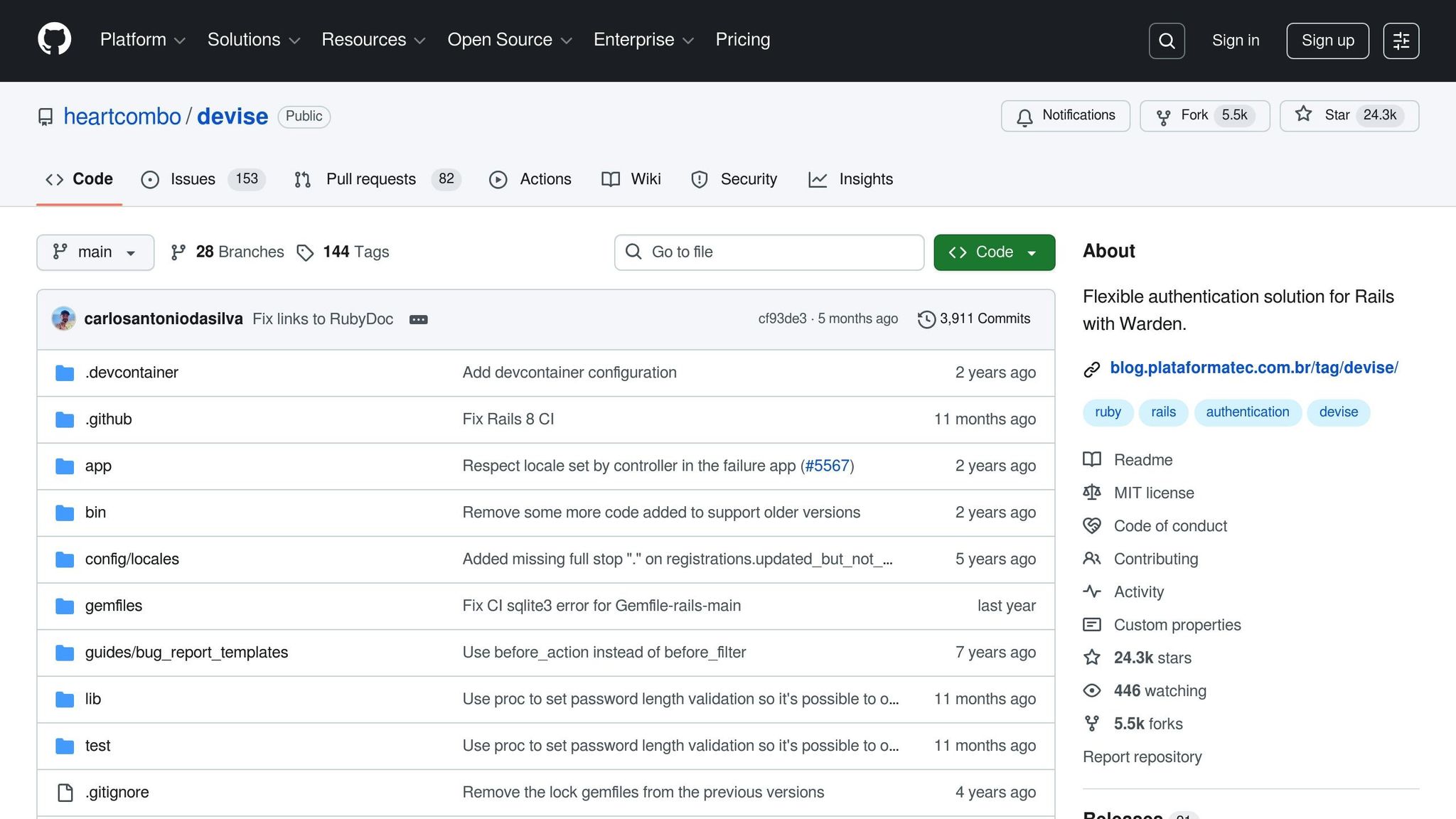
Devise nimmt Ihnen die Mühe ab, Authentifizierungssysteme zu erstellen, indem es die schwere Arbeit für Sie erledigt. Mit Funktionen wie Benutzerregistrierung, Login, Passwortwiederherstellung und Sitzungsmanagement erspart dieses Gem Ihnen die zeitaufwändige Aufgabe, diese Systeme von Grund auf neu zu erstellen. Es ist eine fertige Lösung, die Sie in Nullkommanichts mit einem sicheren Authentifizierungssystem ausstattet.
Zeitersparende Funktionen für die Entwicklung
Devise vereinfacht die Einrichtung mit seinen Generatorbefehlen. Das Ausführen von rails generate devise:install und rails generate devise User erstellt Migrationen, Routen und Controller automatisch. Dieser schnelle Setup spart die Zeit, die Sie sonst mit dem manuellen Kodieren dieser Elemente verbringen würden.
Es bietet auch vorgefertigte Ansichten für gängige Authentifizierungsabläufe. Egal, ob Sie Login-Formulare, Registrierungsseiten, Passwort-Reset-Oberflächen oder Bestätigungsvorlagen per E-Mail benötigen, Devise hat Sie abgedeckt. Diese vorgefertigten Ansichten ermöglichen es Ihnen, sich auf den Aufbau der einzigartigen Funktionen Ihrer App zu konzentrieren, während Ihr Authentifizierungssystem mit den Rails-Konventionen übereinstimmt.
Für zusätzliche Flexibilität ermöglicht die devise.rb Initialisierungsdatei das Anpassen von Einstellungen wie Sitzungszeitüberschreitungen, Passwortkomplexität und E-Mail-Konfigurationen. Beispielsweise stellt die Einstellung config.timeout_in = 30.minutes sicher, dass inaktive Benutzer automatisch abgemeldet werden, was die Sicherheit erhöht, ohne zusätzlichen Codierungsaufwand zu verlangen.
Kompatibilität mit Ruby on Rails
Devise arbeitet Hand in Hand mit den Rails-Konventionen, was die Integration nahtlos macht. Es generiert automatisch Migrationen, richtet Modellassoziationen ein und bietet Rails-Helper wie before_action :authenticate_user!, um Ihre Controller mühelos abzusichern.
Transaktions-E-Mails wie Passwortzurücksetzungen, Kontobestätigungen und Entsperrbenachrichtigungen werden über Rails' ActionMailer abgewickelt, wobei Ihre vorhandene E-Mail-Einrichtung verwendet wird. Dies bedeutet, dass Sie keine zusätzliche Zeit für die Konfiguration dieser wesentlichen Funktionen aufwenden müssen.
Devise unterstützt auch das I18n-Framework von Rails, was es einfach macht, Fehlermeldungen, E-Mail-Vorlagen und Formularbeschriftungen in verschiedene Sprachen zu übersetzen. Das Hinzufügen von Lokalisierungsdateien zu Ihrem Projekt gewährleistet, dass die Authentifizierungsfunktionen Ihrer App für Benutzer in mehreren Sprachen zugänglich sind.
Unterstützung für die Schweizer Lokalisierung
Für Entwickler in der Schweiz ist Lokalisierung entscheidend. Devise unterstützt mehrsprachige Anwendungen, einschließlich Deutsch, Französisch und Italienisch, wodurch es ideal für die Schweizer Zielgruppen ist. Sie können sogar benutzerdefinierte Lokalisierungsdateien erstellen, um regionale Nuancen wie Schweizerdeutsch zu berücksichtigen, sodass die Schnittstelle für lokale Benutzer natürlich wirkt.
Devise integriert sich nahtlos mit dem I18n-Framework von Rails, sodass Anpassungen bei Datumsformaten (z.B. DD.MM.YYYY), Zahlenformatierungen und Währungsanzeigen (CHF) einfach zu implementieren sind. Dies erleichtert die Bereitstellung einer authentifizierenden Erfahrung, die mit schweizerischen Standards und Benutzererwartungen übereinstimmt.
Verbesserung der Codequalität und Arbeitsabläufe
Devise umfasst Standardmethoden wie user_signed_in?, current_user und sign_out, um eine konsistente und zuverlässige Authentifizierung in Ihrer Anwendung sicherzustellen. Diese Methoden reduzieren potenzielle Fehler und vereinfachen Ihren Arbeitsablauf.
Für Tests bietet Devise integrierte Helfer, die mit Frameworks wie RSpec funktionieren. Befehle wie sign_in user erleichtern das Testen von Authentifizierungsabläufen, ohne sie manuell simulieren zu müssen, und stellen sicher, dass kritische Szenarien gründlich abgedeckt sind.
Sicherheit ist von Grund auf in Devise integriert. Mit bereits implementierten Best Practices können Sie sicher sein, dass das Authentifizierungssystem Ihrer App so konzipiert ist, dass es Sicherheitsherausforderungen bewältigen kann, ohne zusätzliche Anpassungen zu benötigen.
3. RSpec
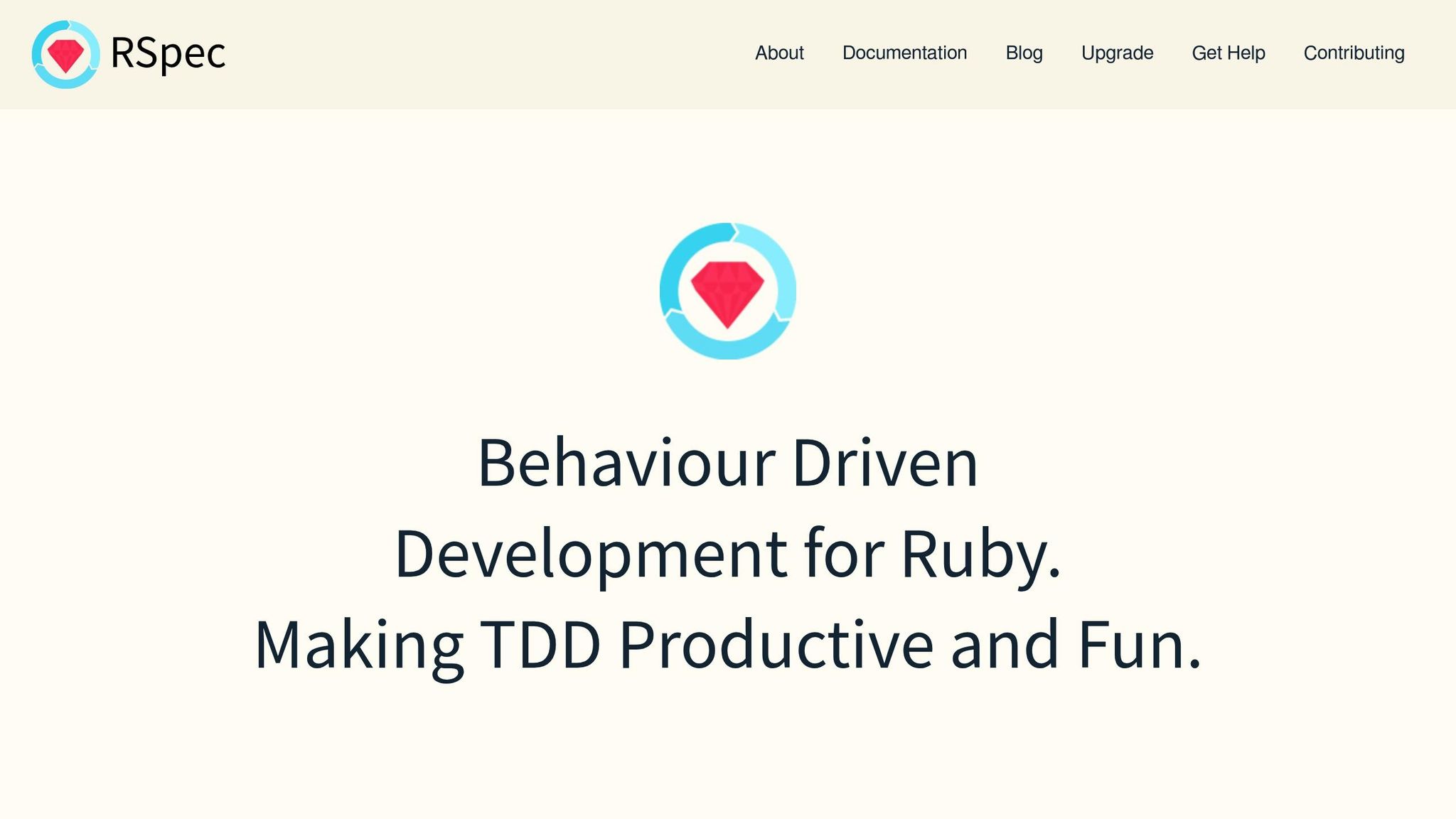
RSpec sticht als leistungsstarkes Werkzeug zum Testen in Ruby hervor und verbessert die Effizienz in jeder Phase der Entwicklung. Es vereinfacht den Prozess der Sicherstellung der Codezuverlässigkeit, dank seines verhaltensgesteuerten Entwicklungsansatzes und der klaren, lesbaren Syntax. Indem es Entwicklern hilft, Probleme frühzeitig zu erkennen, steigert RSpec nicht nur das Vertrauen in den Code, sondern reduziert auch erheblich die Zeit, die mit dem Debuggen von Problemen später verbracht wird.
Zeitersparende Funktionen für die Entwicklung
RSpec bietet eine Reihe von Funktionen, die darauf ausgelegt sind, das Testen schneller und effizienter zu gestalten. Zum Beispiel beseitigen seine Generatorbefehle die Notwendigkeit einer manuellen Einrichtung. Das Ausführen von rails generate rspec:install erstellt automatisch die notwendigen Konfigurationsdateien und die Ordnerstruktur. Ebenso generiert rails generate rspec:model User Testdateien für Ihre Modelle, komplett mit vordefinierter Struktur und Beispielen, damit Sie direkt loslegen können.
Fokussiertes Testen ist ein weiterer Zeitgewinner. Mit fit oder fdescribe können Sie auf spezifische Tests oder Testgruppen fokussieren, was es einfacher macht, Probleme zu isolieren und zu beheben, ohne die gesamte Suite ausführen zu müssen. Dies hält Ihren Feedback-Zyklus kurz und effizient.
Gemeinsame Beispiele sind eine weitere nützliche Funktion. Durch die Definition gemeinsamer Verhaltensweisen mit shared_examples_for "auditable" können Sie diese über mehrere Modelle hinweg wiederverwenden, indem Sie it_behaves_like "auditable" verwenden. Dies reduziert sich wiederholenden Code und sorgt für konsistente Testabdeckung. Außerdem helfen RSpec's integrierte Mocking- und Stubbing-Werkzeuge, Abhängigkeiten zu isolieren, was die Tests effektiver und fokussierter macht.
Kompatibilität mit Ruby on Rails
RSpec integriert sich nahtlos mit Ruby on Rails über das rspec-rails Gem, das sich an die Rails-Konventionen anpasst, um die Entwicklungsgeschwindigkeit und Zuverlässigkeit zu verbessern. Es arbeitet direkt mit der Testdatenbank von Rails, unterstützt rails-spezifische Matcher wie be_valid, have_many(:posts) und validate_presence_of(:email) und bietet Werkzeuge für die Tests von Controllern, Modellen und Ansichten mit minimaler Konfiguration.
Wenn es um Controller-Tests geht, vereinfacht RSpec den Prozess mit intuitiven Helfern. Beispielsweise können Sie das HTTP-Verhalten mit Befehlen wie get :show, params: { id: 1 } und Assertions wie expect(response).to have_http_status(:success) testen.
RSpec stellt auch saubere Testumgebungen sicher, indem es die transaktionalen Fixtures von Rails nutzt, die Datenbankänderungen nach jedem Test zurücksetzen. Dies verhindert Datenkontamination und hält Ihre Tests konsistent und zuverlässig.
Verbesserung der Codequalität und Arbeitsabläufe
Eine der herausragenden Funktionen von RSpec ist seine Rolle als lebende Dokumentation. Beschreibungen wie describe "when user is authenticated" und it "returns user's posts" entwickeln sich zusammen mit Ihrem Code und bieten wertvolle Einblicke in das Verhalten des Systems.
Benutzerdefinierte Matcher sind eine weitere Möglichkeit, wie RSpec die Lesbarkeit und Wartbarkeit verbessert. Anstatt komplexe Erwartungen zu formulieren, können Sie domänenspezifische Assertions wie expect(user).to be_admin oder expect(response).to include_error_message("Ungültige E-Mail") verwenden. Das macht Tests verständlicher und einfacher zu warten.
RSpecc’s Hook-System optimiert den Prozess weiter, indem es den Test-Setup und -Teardown automatisiert. Mit Blöcken wie before(:each) und after(:all) können Sie Testdaten vorbereiten und Ressourcen bereinigen, ohne sich wiederholenden Boilerplate-Code zu verwenden, was eine konsistente Testumgebung sicherstellt.
Für größere Projekte unterstützt RSpec paralleles Testen, wodurch Sie Tests über mehrere CPU-Kerne hinweg ausführen können. Dies beschleunigt die Testausführung, selbst wenn Ihre Anwendung und Ihre Test-Suite wachsen.
Schließlich erleichtert RSpec’s detaillierte Fehlerberichterstattung mit klaren Stack-Traces und Zeile-für-Zeile-Diffs das Identifizieren und Beheben von Problemen schneller und unkomplizierter.
4. RuboCop
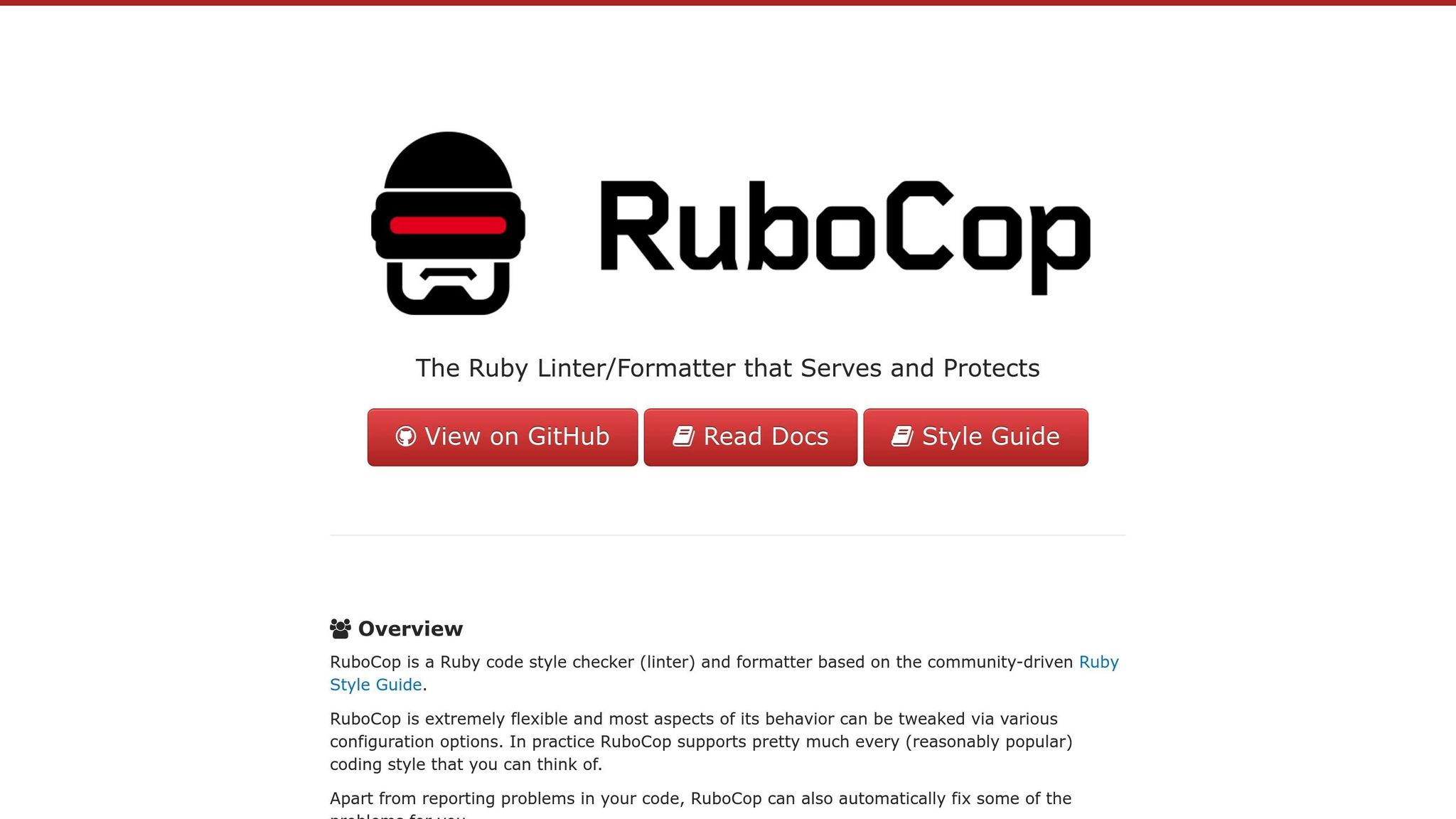
RuboCop hilft, Stilrichtlinien durchzusetzen und Probleme frühzeitig zu erkennen, indem es dem Ruby Style Guide der Community folgt. Sein Ziel? Halten Sie Ihren Code sauber, lesbar und leicht wartbar. Indem es Stilüberprüfungen automatisiert, reduziert es manuelle Überprüfungen und beschleunigt die Entwicklung bei gleichzeitiger Sicherstellung einer starken Codequalität.
Zeitersparende Funktionen für die Entwicklung
Eine der herausragenden Funktionen von RuboCop ist seine Fähigkeit, Stilverletzungen automatisch zu beheben. Anstatt Zeit mit sich wiederholenden Aufgaben wie dem Beheben von Einrückungen oder dem Entfernen überflüssiger Leerzeichen zu verbringen, können Sie rubocop --auto-correct ausführen, um diese für Sie zu erledigen. Bei komplexeren Problemen - wie übermäßig langen Methoden oder hoher zyklomatischer Komplexität - kümmert sich rubocop --auto-correct-all darum.
Sie können RuboCop an Ihre Projektanforderungen anpassen, indem Sie die .rubocop.yml Datei konfigurieren. Dies ermöglicht es Ihnen, spezifische Regeln festzulegen, bestimmte Verzeichnisse auszuschließen, bestimmte Cops zu deaktivieren oder Schweregrade anzupassen. Diese Anpassung optimiert nicht nur Ihren Workflow, sondern reduziert auch Streitigkeiten über den Codestil, sodass Sie sich auf den Aufbau von Funktionen konzentrieren können.
RuboCop unterstützt auch die parallele Verarbeitung mit der --parallel Option und nutzt mehrere CPU-Kerne, um die Codeanalyse zu beschleunigen. Dies ist besonders nützlich in kontinuierlichen Integrationsumgebungen, wo schnellere Rückmeldungen und kürzere Build-Zeiten entscheidend sind. Für Rails-Projekte gewährleistet diese Effizienz eine konsistente Qualität in der gesamten Anwendung.
Kompatibilität mit Ruby on Rails
RuboCop funktioniert nahtlos mit Rails-Anwendungen, dank der rubocop-rails Erweiterung. Diese Erweiterung enthält Rails-spezifische Regeln, die Ihnen helfen, den Konventionen des Frameworks zu folgen und die ActiveRecord-Nutzung zu optimieren. Außerdem hebt es potenzielle Ineffizienzen hervor, wie langsame Datenbankabfragen oder unsachgemäße Verwendung von Callbacks, und kennzeichnet häufige Sicherheitsrisiken.
Wenn Sie in einem Rails-Projekt neue Dateien generieren, kann RuboCop diese automatisch überprüfen, um sicherzustellen, dass sie von Anfang an Ihren Qualitätsstandards entsprechen. Darüber hinaus erweitern Werkzeuge wie rubocop-rspec diese Fähigkeiten auf Ihre Test-Suite und bieten Stilüberprüfungen, die speziell für Rails-basierte Tests zugeschnitten sind.
Verbesserung der Codequalität und Arbeitsabläufe
RuboCop geht über grundlegende Formatierung hinaus. Sein umfangreiches Regelset kann Probleme wie übermäßig komplexe Methoden, ungenutzte Variablen und sogar potenzielle Sicherheitsanfälligkeiten erkennen - alles, bevor sie in die Produktion gelangen. Dieser proaktive Ansatz fördert besseres Softwaredesign und Architektur.
Für Teams mit einzigartigen Bedürfnissen können benutzerdefinierte Cops projektspezifische Regeln durchsetzen, sodass RuboCop sich zusammen mit Ihrem Code weiterentwickelt. Detaillierte Berichte, die Zeilennummern und vorgeschlagene Korrekturen enthalten, integrieren sich nahtlos in Entwicklungstools und CI-Systeme, was die Behebung von Problemen erleichtert.
Um die Codequalität zu gewährleisten, können Sie RuboCop mit Git über Pre-Commit-Hooks integrieren. Diese Hooks verhindern, dass Stilverletzungen in das Repository gelangen. Und wenn Sie in einer großen Codebasis arbeiten, fokussiert die --diff Option Überprüfungen nur auf die geänderten Zeilen, was die Pre-Commit-Überprüfungen effizient hält, ohne Ihren Workflow zu verlangsamen.
5. FactoryBot
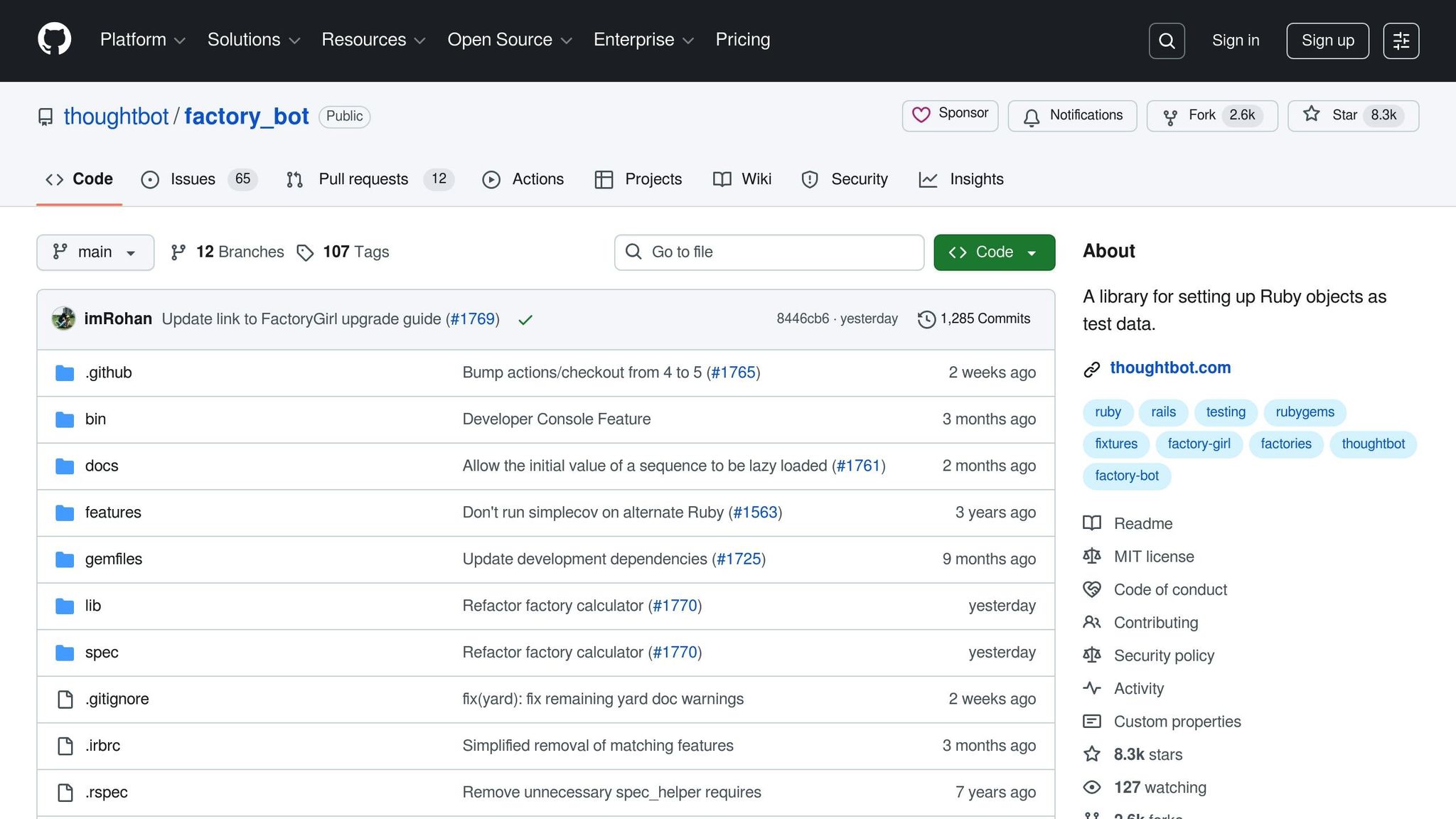
FactoryBot vereinfacht die Erstellung von Testdaten, indem es veraltete Fixtures durch dynamische, anpassbare Fabriken ersetzt. Anstatt sich mit statischen YAML-Dateien herumschlagen zu müssen, die schnell irrelevant werden können, definieren Sie flexible Blaupausen für Ihre Modelle. Diese Blaupausen erzeugen frische Daten nach Bedarf, was Zeit und Aufwand spart. Durch die Reduzierung des manuellen Setups von Testdaten beschleunigt FactoryBot die Entwicklung und verbessert die Codequalität. Es beseitigt auch den Aufwand der Verwaltung von Fixtures und gibt Ihnen die volle Kontrolle über Ihre Testszenarien.
Zeitersparende Funktionen für die Entwicklung
FactoryBot bietet Build-Strategien, die die Erstellung von Testobjekten schnell und effizient gestalten. Egal, ob Sie nicht gespeicherte Instanzen (build), gespeicherte Datensätze (create) oder einfach Attribut-Hashes (attributes_for) benötigen, Sie können alles aus einer einzigen Fabrik generieren. Diese Vielseitigkeit ermöglicht es Ihnen, Fabrikdefinitionen in verschiedenen Testfällen problemlos wiederzuverwenden.
Eine weitere nützliche Funktion ist die Fabrikerben, die helfen, sich wiederholenden Code zu reduzieren. Beispielsweise können Sie eine Basis-user Fabrik definieren und sie erweitern, um spezialisierte Versionen wie admin_user oder premium_user zu erstellen. Diese spezialisierten Fabriken erben die Basiseigenschaften, ermöglichen es Ihnen jedoch, spezifische hinzuzufügen, wodurch Ihr Testdaten-Setup vereinfacht wird.
Das Trait-System von FactoryBot fügt noch mehr Flexibilität hinzu. Traits lassen Sie Objektzustände wie with_profile, suspended oder verified definieren, die Sie nach Bedarf kombinieren können. Zum Beispiel generiert create(:user, :with_profile, :verified) einen Benutzer mit sowohl einem Profil als auch dem Status verifiziert. Dieser modulare Ansatz bedeutet, dass Sie nicht dutzende separate Fabrikvarianten erstellen müssen, wodurch Ihr Testsetup sauberer und effizienter wird.
Kompatibilität mit Ruby on Rails
FactoryBot funktioniert nahtlos mit Rails und erkennt automatisch Ihre Modelle und deren Assoziationen. Wenn Ihr Modell belongs_to Beziehungen hat, erstellt FactoryBot die zugehörigen Datensätze automatisch, um sicherzustellen, dass Ihre Testdaten ordnungsgemäß Beziehungen beibehalten, ohne dass zusätzliche Konfiguration erforderlich ist.
Es integriert sich auch gut mit ActiveRecord-Callbacks und -Validierungen. Wenn eine Fabrik versucht, einen ungültigen Datensatz zu erstellen, erfahren Sie dies sofort, was Ihnen hilft, Validierungsprobleme frühzeitig zu erkennen, statt während der Testausführung.
Für Rails-Entwickler ist das Assoziationshandling des Gems ein herausragendes Merkmal. Sie können komplexe Objektbeziehungen mit Syntax wie association :company oder company { create(:company) } einfach definieren. FactoryBot kümmert sich um die Erstellungsreihenfolge und sorgt dafür, dass übergeordnete Datensätze vorhanden sind, bevor untergeordnete Datensätze erstellt werden, sodass Sie sich nicht um die manuelle Verwaltung von Abhängigkeiten kümmern müssen.
Verbesserung der Codequalität und Arbeitsabläufe
FactoryBot fördert ein besseres Testdesign, indem es Tests dazu ermutigt, nur die Daten zu generieren, die sie benötigen. Im Gegensatz zu gemeinsamen Fixtures, die verborgene Abhängigkeiten zwischen Tests schaffen können, sorgt FactoryBot dafür, dass jeder Test isoliert bleibt. Dies macht Tests zuverlässiger und einfacher zu debuggen, wenn etwas schiefgeht.
Die expliziten Fabrikdefinitionen des Gems dienen auch als exzellente Dokumentation für Ihre Modelle. Neue Teammitglieder können schnell verstehen, welche Attribute ein Modell erwartet, nur durch den Blick auf die Fabriken. Darüber hinaus werden alle Änderungen an den Anforderungen eines Modells sofort offensichtlich, wenn Sie die Fabriken aktualisieren.
Schließlich können stubbed objects, die mit build_stubbed erstellt werden, Ihre Test-Suite erheblich beschleunigen. Diese Objekte ahmen gespeicherte Datensätze nach, überspringen jedoch die Datenbankpersistenz, sodass Unit-Tests schneller laufen, während sie immer noch wie echte ActiveRecord-Objekte funktionieren. Dieses Gleichgewicht zwischen Geschwindigkeit und Funktionalität ist ein Game-Changer zur Verbesserung der Testleistung.
6. Sidekiq

Sidekiq kümmert sich um die zeitaufwändigen Aufgaben, die Ihre App verlangsamen können. Durch das Queuing von Aufgaben wie das Versenden von E-Mails, das Verarbeiten von Bildern oder das Erstellen von Berichten stellt es sicher, dass Ihre Benutzeroberfläche reaktionsschnell bleibt. Es nutzt Redis, um Jobs zu speichern, und kann mehrere Aufgaben gleichzeitig verarbeiten, was es sowohl effizient als auch ressourcenschonend macht.
Zeitersparende Funktionen für die Entwicklung
Dank seines Multithread-Designs kann Sidekiq zahlreiche Jobs gleichzeitig mit nur einem Prozess verarbeiten. Dies kann erheblich die benötigten Serverressourcen für Hintergrundaufgaben reduzieren. Darüber hinaus enthält es eine eingebaute Web-Benutzeroberfläche zur Überwachung der Job-Queues in Echtzeit. Sidekiq unterstützt auch die Planung von Jobs, sodass Sie Aufgaben zu bestimmten Zeiten oder nach Verzögerungen ausführen können. Sie können beispielsweise eine Aufgabe mit einem einfachen Ruby-Befehl wie MyWorker.perform_in(1.hour, user_id) planen. Das erleichtert das Deployment und reduziert den Bedarf an externen Planungstools, was es zu einer großartigen Wahl für Rails-Apps macht.
Kompatibilität mit Ruby on Rails
Sidekiq funktioniert mühelos mit Rails und integriert sich nahtlos durch ActiveJob, Rails' nativen Job-Rahmen. Mit diesem Setup können Sie sich an die standardmäßige Rails-Job-Syntax halten und gleichzeitig die Geschwindigkeit und Effizienz von Sidekiq nutzen, oft ohne viel Code umschreiben zu müssen. Es respektiert auch Ihre Rails-Umgebungseinstellungen wie Datenbankkonfigurationen, Protokollierung und Umgebungsvariablen. Darüber hinaus können Sie ActiveRecord-Modelle und -Assoziationen innerhalb von Sidekiq-Jobs verwenden, sodass Hintergrundaufgaben Datenbankabfragen bearbeiten, Datensätze aktualisieren und Beziehungen verwalten können - genau so, wie Sie es in Ihrer Hauptanwendung tun würden.
Unterstützung für die Schweizer Lokalisierung
Obwohl Sidekiq keine integrierten Lokalisierungstools mitbringt, kann es schweizerische Geschäftsanforderungen problemlos abdecken. Zum Beispiel unterstützt es Operationen mit mehreren Währungen wie CHF und verarbeitet mehrsprachige Inhalte. Mit den richtigen Zeitzoneneinstellungen in Ihrer Rails-App können Sie Aufgaben so konfigurieren, dass sie entsprechend der Mitteleuropäischen Zeit (CET/CEST) ausgeführt werden. Alle Lokalisierungsanforderungen, wie die Formatierung von Schweizer Währungen oder mehrsprachige Anpassungen, können direkt in Ihrem Anwendungscode implementiert werden.
Verbesserung der Codequalität und Arbeitsabläufe
Indem langsame Operationen in den Hintergrund verschoben werden, hilft Sidekiq Ihnen dabei, eine sauberere, besser verwaltbare Anwendungsstruktur aufrechtzuerhalten. Sein automatischer Retry-Mechanismus mit exponentiellem Backoff stellt sicher, dass fehlgeschlagene Jobs erneut in die Warteschlange gestellt werden, wodurch Ihre Anwendung zuverlässig bleibt. Darüber hinaus bietet Sidekiq Testwerkzeuge, die es einfacher machen, das Verhalten von Jobs und das Queuing zu überprüfen, ohne die Produktion zu beeinträchtigen. Dies verbessert nicht nur die Codequalität, sondern hilft auch, Probleme zu erkennen, bevor sie Ihre Benutzer erreichen.
7. Kaminari
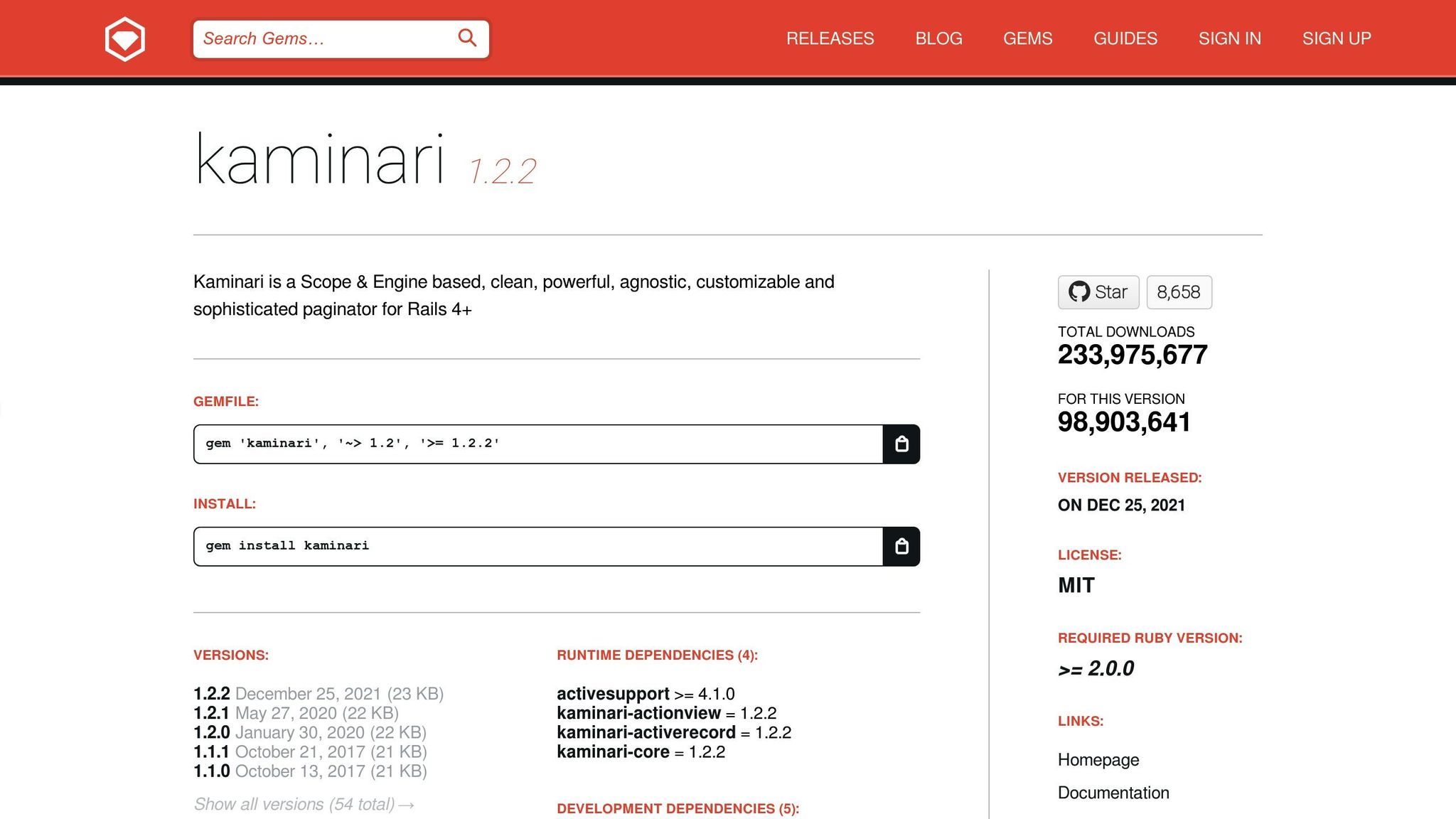
Kaminari vereinfacht die Pagination, indem große Datensätze in kleinere, besser verwaltbare Seiten unterteilt werden. Anstatt Ihre Anwendung zu überlasten, indem Sie Tausende von Datensätzen auf einmal laden, unterteilt es den Inhalt in Seiten und bietet saubere Navigationskontrollen. Dieses Gem arbeitet mühelos mit Ihren vorhandenen ActiveRecord-Abfragen und unterstützt mehrere Ansichtsframeworks, was es zu einer praktischen Wahl für Entwickler macht.
Zeitersparende Funktionen für die Entwicklung
Kaminari eliminiert die Notwendigkeit für benutzerdefinierte Paginierungslogik. Mit einem einfachen .page(params[:page]) Befehl können Sie jede ActiveRecord-Beziehung sofort paginieren. Das Gem kümmert sich um Seitenzahlen, Randfälle und bietet sogar Hilfsmethoden zur Erstellung von Navigationslinks. Seine integrierten Ansichtshelfer machen das Erstellen von Paginierungssteuerungen zum Kinderspiel und sparen Ihnen Stunden Programmier- und Testzeit.
Es ermöglicht auch die Anpassung der Anzahl pro Seite mit .per(25) und optimiert die Leistung, indem es LIMIT und OFFSET Klauseln verwendet, anstatt alle Datensätze in den Speicher zu laden. Dies stellt sicher, dass Ihre Anwendung reaktionsschnell bleibt, selbst beim Umgang mit komplexen Abfragen.
Kompatibilität mit Ruby on Rails
Kaminari passt perfekt zu Rails-Entwicklungsmethoden und integriert sich nahtlos in ActiveRecord und unterstützt wichtige Datenbanken wie PostgreSQL, MySQL und SQLite. Es respektiert Ihre Modellassoziationen und Scopes, sodass Sie selbst durch die komplexesten Beziehungen paginieren können, ohne zusätzliche Einrichtung. Darüber hinaus funktioniert es mit den Caching-Mechanismen von Rails, sodass Sie paginierte Ergebnisse für bessere Leistung cachen können.
Für die API-Entwicklung bietet Kaminari JSON-freundliche Paginierungsmetadaten mit Hilfsmethoden wie current_page, total_pages und total_count. Diese Tools erleichtern den Aufbau von RESTful APIs, die paginierte Daten liefern, vollständig mit Navigationsdetails für Frontend-Anwendungen.
Unterstützung für die Schweizer Lokalisierung
Kaminari ist gut für Schweizer Benutzer geeignet und bietet mehrsprachige Paginierungssteuerelemente, die sich an Sprachen wie Deutsch und Französisch anpassen. Durch das I18n-System von Rails können Sie Navigationsbeschriftungen wie "Nächste" (Next) oder "Suivant" basierend auf den Spracheinstellungen der Anwendung anpassen.
Das Gem hält sich auch an die Schweizer Zahlenformatierungsstandards und verwendet die korrekten Tausendertrennzeichen (z.B. 1'000 statt 1,000), wenn Seitenzahlen angezeigt werden. Dies stellt sicher, dass Ihre paginierten Schnittstellen intuitiv sind und den lokalen Erwartungen entsprechen.
Verbesserung der Codequalität und Arbeitsabläufe
Durch die Handhabung der Pagination auf Datenbankebene verhindert Kaminari Leistungsengpässe, die durch das Laden großer Datensätze entstehen. Es ermutigt Entwickler, Daten in kleineren, effizienten Mengen abzurufen und fördert so bessere Abfragestrukturen.
Kaminari enthält auch Testhelfer, um das Überprüfen des Paginierungsverhaltens zu erleichtern. Sie können Seitenzahlen testen, Randfälle navigieren und sicherstellen, dass Ihre Logik in verschiedenen Szenarien funktioniert. Dies führt zu zuverlässigeren Anwendungen, bei denen weniger Bugs in die Produktion gelangen.
Darüber hinaus vereinfacht Kaminari den Controller-Code, indem es die Paginierungslogik in prägnante Methodenaufrufe abstrahiert. Dies hält Ihren Code sauber, wartbar und leichter für Teammitglieder zu verstehen und zu verbessern.
8. ActiveAdmin

ActiveAdmin vereinfacht die Erstellung von Admin-Schnittstellen, indem es funktionale Dashboards und Tools mit nur wenigen Zeilen Code generiert. Ein einzelner Befehl wie ActiveAdmin.register Product kann CRUD-Operationen, Suchmöglichkeiten und Datenfilterung ohne zusätzlichen Aufwand einrichten. Dies beseitigt die sich wiederholenden Aufgaben beim Erstellen von Formularen, Tabellen und Navigationsmenüs, wodurch es zu einer bevorzugten Lösung für Entwickler wird, die mit Ruby arbeiten.
Zeitersparende Funktionen für die Entwicklung
ActiveAdmin’s DSL (Domain-Specific Language) macht es einfach, Admin-Ressourcen zu definieren, die automatisch Formulare, Filter und Batch-Aktionen generieren. Batch-Operationen sind besonders nützlich für die Handhabung großer Datensätze. Administratoren können mehrere Datensätze auswählen und Aufgaben wie Statusaktualisierungen, das Löschen von Einträgen oder das Exportieren von Daten in CSV-Dateien ausführen - alles ohne manuelle Intervention. Diese Werkzeuge sparen nicht nur Zeit, sondern reduzieren auch die Wahrscheinlichkeit von Fehlern.
Benutzerdefinierte Dashboards bringen sofortige Einblicke in Anwendungsdaten. Entwickler können Widgets, Diagramme und zusammenfassende Statistiken verwenden, um eine maßgeschneiderte Ansicht zu erstellen, die nahtlos mit den nativen Funktionen von Rails integriert ist.
Kompatibilität mit Ruby on Rails
Als Rails-Engine integriert sich ActiveAdmin reibungslos in Projekte und funktioniert gut mit Authentifizierungssystemen wie Devise. Die Einrichtung ist unkompliziert: Fügen Sie das Gem zu Ihrer Gemfile hinzu und führen Sie einen Generatorbefehl aus, um es zu konfigurieren. Es unterstützt Rails 6 und 7 und nutzt Kernfunktionen von Rails wie starke Parameter, Modellassoziationen und Caching.
Unterstützung für die Schweizer Lokalisierung
ActiveAdmin erfüllt auch mühelos die Anforderungen an die Schweizer Lokalisierung. Die Admin-Oberfläche kann sich je nach Benutzereinstellungen an Deutsch, Französisch, Italienisch oder Englisch anpassen, um eine vertraute Erfahrung für Benutzer in der gesamten Schweiz zu gewährleisten.
Die Währungsformatierung wird mühelos mit den Lokalisierungshelfern von Rails behandelt. Beispielsweise können Produktpreise in Schweizer Franken mit der korrekten Formatierung angezeigt werden:
Ebenso entsprechen Datums- und Zahlenformate den Schweizer Konventionen. Daten werden im Format DD.MM.YYYY angezeigt, während Zahlen Kommas für Dezimalzahlen und Punkte für Tausender verwenden, sodass die Schnittstelle für Schweizer Benutzer intuitiv wirkt.
Verbesserung der Codequalität und Arbeitsabläufe
ActiveAdmin fördert eine konsistente Code-Struktur, indem es sich an die Rails-Konventionen hält. Funktionen wie CSRF-Schutz, Parameterfilterung und die Kompatibilität mit Autorisierungs-Gems verbessern die Sicherheit und Zuverlässigkeit. Die Integration mit RSpec gewährleistet robuste Tests, was hilft, Fehler zu reduzieren und das Onboarding neuer Teammitglieder zu beschleunigen.
Für Unternehmen, die unter strengen Regulierungen arbeiten, sind die Audit-Funktionen von ActiveAdmin von unschätzbarem Wert. Es protokolliert administrative Aktionen und verfolgt Datenänderungen, was Unternehmen hilft, den Schweizer Datenschutzgesetzen zu entsprechen.
Schweizer Fachleute bei USEO verlassen sich auf ActiveAdmin, um skalierbare, benutzerdefinierte Admin-Oberflächen zu erstellen, die lokale Anforderungen an Compliance und Lokalisierung erfüllen.
9. CarrierWave
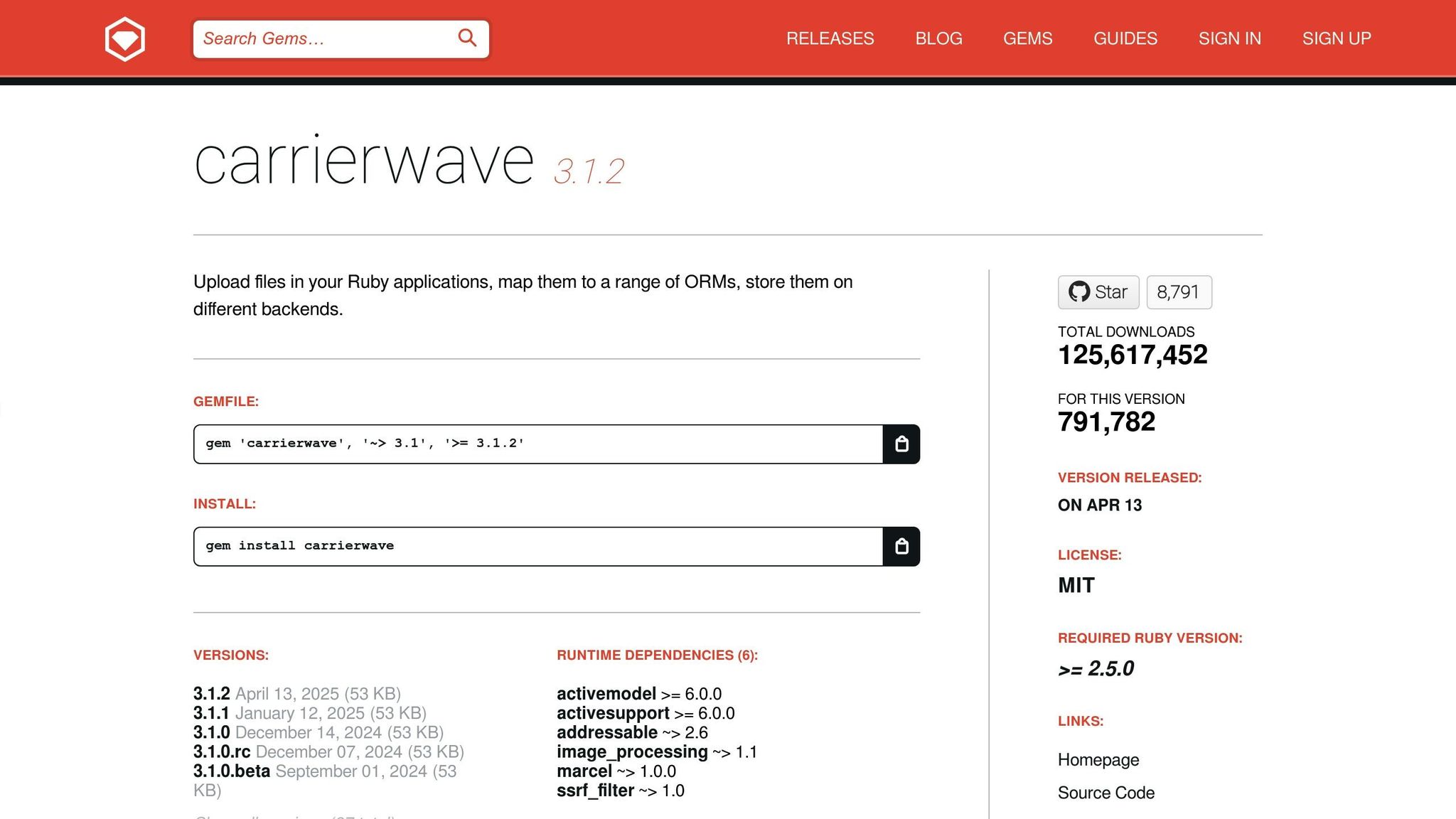
Wenn Rails-Projekte reifen und über grundlegende Administration und Tests hinausgehen, wird die effiziente Verwaltung von Dateien zu einem kritischen Bedürfnis. CarrierWave tritt in Aktion, um das Management von Dateiuploads für Ruby-Anwendungen zu vereinfachen und bietet eine saubere, objektorientierte Möglichkeit, Bilder, Dokumente und andere Mediendateien zu handhaben. Mit CarrierWave können Entwickler Uploader-Klassen erstellen, die Aufgaben wie Verarbeitung, Speicherung und Validierung von Dateien automatisch übernehmen. Es kümmert sich um mühsame Details wie die Verwaltung von Dateipfaden, das Erstellen von Verzeichnissen und die Implementierung von Sicherheitsmaßnahmen.
Zeitersparende Funktionen für die Entwicklung
CarrierWave zentralisiert alle file-bezogenen Logik und macht die Entwicklung schneller und effizienter. Beispielsweise kann es automatisch mehrere Versionen einer Datei - wie Thumbnails - nach der Verarbeitung erstellen. Es enthält auch integrierte Validierungsfunktionen, um die Dateigröße, das Format und den Inhaltstyp zu überprüfen, während es Dateinamen bereinigt, um Sicherheit und Kompatibilität auf verschiedenen Betriebssystemen sicherzustellen.
Darüber hinaus ist die Einrichtung der Cloud-Speicherung mit Diensten wie Amazon S3 oder Google Cloud Storage unkompliziert. Dies ermöglicht Ihrer Anwendung, mühelos zu skalieren, ohne dass Codeänderungen erforderlich sind.
Kompatibilität mit Ruby on Rails
CarrierWave integriert sich nahtlos mit Ruby on Rails. Durch das Hinzufügen einer einzigen Montage-Deklaration zu einem ActiveRecord-Modell können Sie Dateiuploads aktivieren, wobei das Gem die erforderlichen Accessor-Methoden bereitstellt, um sie zu handhaben. Es hält sich an die Rails-Konventionen und sorgt für eine reibungslose Kompatibilität mit Formularhelfern, was das Erstellen von Upload-Formularen zum Kinderspiel macht.
Das Gem unterstützt Rails 6 und 7 und nutzt moderne Funktionen wie starke Parameter. Es funktioniert auch gut mit Hintergrundjob-Prozessoren und ermöglicht die asynchrone Datei-Verarbeitung, sodass Benutzeranfragen nicht blockiert werden.
Unterstützung für die Schweizer Lokalisierung
CarrierWave’s Dateinamenbehandlung ist anpassbar, was es perfekt für mehrsprachige Uploads macht. Durch das Überschreiben der sanitize_regexp Methode können Entwickler lokale Skripte und Unicode-Zeichen wie deutsche Umlaute, französische Akzente und italienische Sonderzeichen unterstützen. Darüber hinaus integriert sich das Gem mit dem I18n-Framework von Rails, sodass Validierungsfehlermeldungen lokalisiert werden können. Mit der carrierwave-i18n Bibliothek wird diese Unterstützung auf noch mehr Sprachen ausgeweitet, sodass Benutzer Fehlermeldungen in Deutsch, Französisch, Italienisch oder Englisch sehen können, je nach ihrer Präferenz.
Obwohl CarrierWave keine Währungs-Lokalisierung behandelt, funktioniert es gut mit E-Commerce-Plattformen, die mehrsprachige Bilder oder Dokumente benötigen, und stellt sicher, dass die Lokalisierungsunterstützung für eine Vielzahl von Inhalten gewährleistet ist.
Verbesserung der Codequalität und Arbeitsabläufe
CarrierWave hilft, sauberen Code aufrechtzuerhalten, indem es die Logik für die Dateibehandlung von der Geschäftsanwendungslogik trennt. Uploader-Klassen folgen dem Prinzip der einzelnen Verantwortung, was sie einfacher zu testen und zu warten macht. Diese Trennung gewährleistet auch eine konsistente API, was die Lernkurve für neue Teammitglieder verringert und Implementierungsfehler minimiert. Durch die Isolierung der Datei-Verarbeitungslogik innerhalb dedizierter Uploader-Klassen wird die Versionskontrolle einfacher. Änderungen nachverfolgen, Funktionen hinzufügen und Fehlerbehebung sind alles leichter zu handhaben.
Schweizer Entwicklungsteams, wie die bei USEO, verlassen sich auf CarrierWave, um zuverlässige Dateiupload-Systeme aufzubauen. Diese Systeme erledigen nicht nur mehrsprachige Inhalte, sondern erfüllen auch lokale Anforderungen an die Datenverarbeitung und -speicherung, wodurch CarrierWave eine hervorragende Wahl für Projekte in der Schweiz ist.
10. Rdkafka
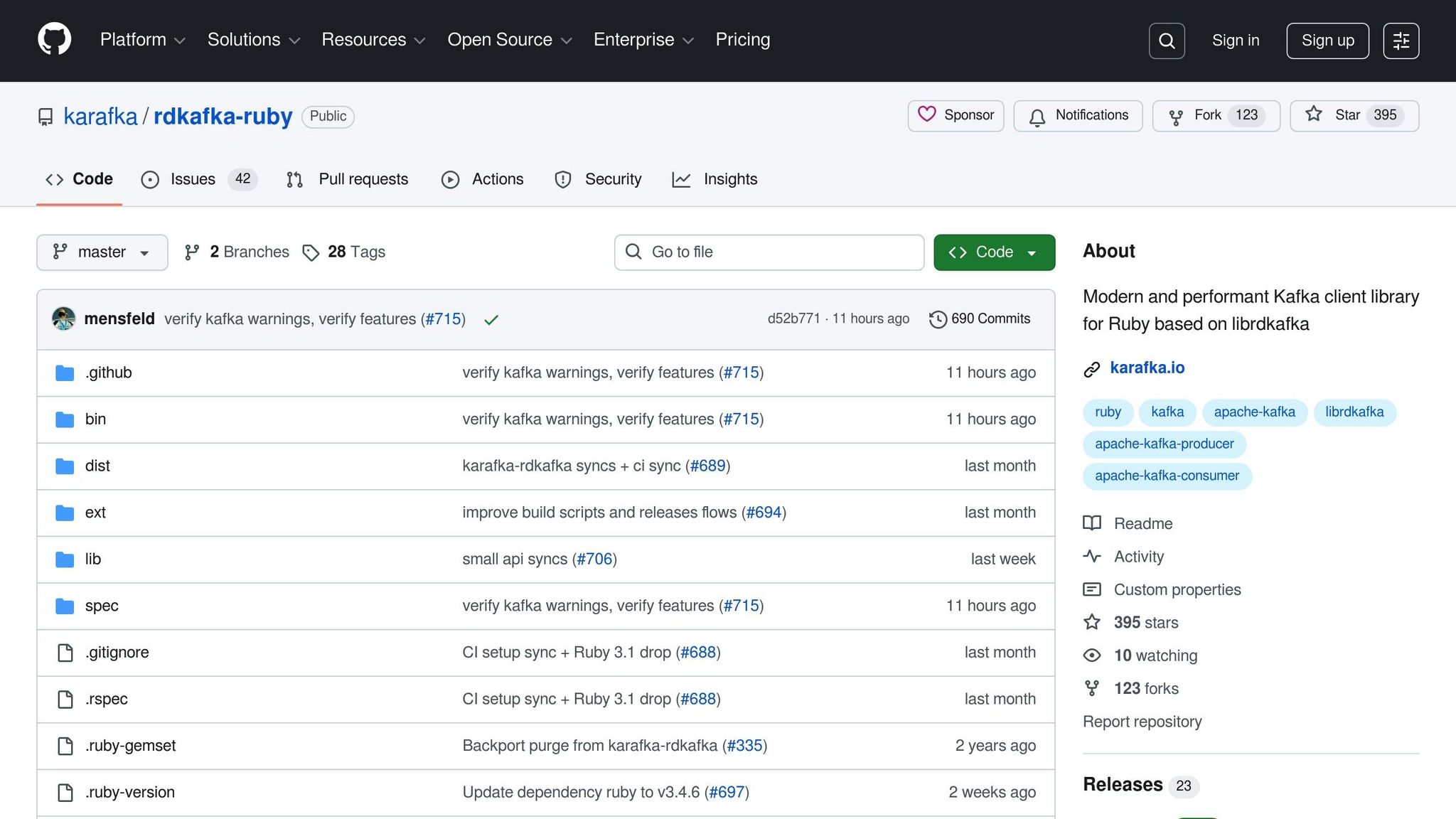
Für Ruby-Anwendungen, die hochvolumige Datenströme verarbeiten oder die Kommunikation zwischen Mikrodiensten erleichtern müssen, bietet Rdkafka eine leistungsstarke Integration mit Apache Kafka. Basierend auf der librdkafka C-Bibliothek bietet dieses Gem einen Hochleistungs-Client zum Produzieren und Konsumieren von Nachrichten, was es ideal für die Verarbeitung von Echtzeitdaten, Ereignis-Streaming und verteilte Systeme macht.
Was Rdkafka hervorhebt, ist seine Abhängigkeit von der librdkafka Bibliothek, die für ihre Geschwindigkeit und Zuverlässigkeit bekannt ist. Dies macht es besonders nützlich in Branchen wie Fintech, E-Commerce und IoT, wo die präzise Verarbeitung großer Mengen von Nachrichten entscheidend ist. Darüber hinaus vereinfacht Rdkafka wie andere Ruby-Gems die Entwicklung, indem viele der mit der Kafka-Integration verbundenen Komplexitäten automatisiert werden.
Zeitersparende Funktionen für die Entwicklung
Rdkafka’s Design priorisiert Effizienz. Es bietet eine saubere Ruby-API, die Kafka-Operationen vereinfacht und Aufgaben wie Verbindungsmanagement und Datenserialisierung übernimmt. Dies reduziert die Notwendigkeit von sich wiederholendem Boilerplate-Code. Sein unkompliziertes Konfigurationssystem ermöglicht es Entwicklern, Kafka-Produzenten und -Konsumenten mit minimalem Aufwand einzurichten.
Das Gem enthält auch Funktionen wie automatische Wiederholungen für fehlgeschlagene Operationen und detaillierte Protokollierung. Egal, ob Ihre Anwendung synchrone oder asynchrone Nachrichtenverarbeitung benötigt, Rdkafka bietet beide Optionen, sodass Sie die beste Lösung für Ihre Leistungsanforderungen wählen können.
Kompatibilität mit Ruby on Rails
Rdkafka integriert sich mühelos mit Ruby on Rails. Es verwendet threadsichere Initialisierer, die gut mit dem Startsystem von Rails funktionieren, was das Setup der Kafka-Verbindung reibungslos und konsistent macht. Darüber hinaus integriert es sich mit dem Protokollierungsrahmen von Rails, sodass Kafka-Ereignisse ordnungsgemäß in den Anwendungsprotokollen aufgezeichnet werden.
Für Anwendungen, die auf Hintergrundjobs angewiesen sind, kann Rdkafka mit Active Job kombiniert werden, um Kafka-Nachrichten effizient zu verarbeiten. Dies stellt sicher, dass Ihre Anwendung selbst unter schwerem Nachrichtenaufkommen reaktionsfähig bleibt und ein nahtloses Benutzererlebnis bietet.
Unterstützung für die Schweizer Lokalisierung
Für Entwickler, die den mehrsprachigen Markt der Schweiz anvisieren, verarbeitet Rdkafka UTF-8-Nachrichten und gewährleistet eine reibungslose Verarbeitung von deutschen, französischen und italienischen Zeichen. Während es keine integrierten Funktionen für Währungsformatierungen oder Zeitzonenumwandlungen bietet, ermöglicht seine flexible API eine einfache Implementierung benutzerdefinierter Lokalisierungen. Beispielsweise können Entwickler die Handhabung von Zeitstempeln oder anderen regionalen Formaten anpassen, um sie an die CET/CEST-Zeitzonen und lokalen Standards der Schweiz anzupassen.
Verbesserung der Codequalität und Arbeitsabläufe
Rdkafka fördert eine saubere Trennung von Anliegen, indem es die Nachrichtenproduktion und -konsumption von der Geschäftsanwendungslogik isoliert. Seine Produzenten- und Konsumentenklassen folgen den Ruby-Konventionen, was den Code einfacher zu warten und zu testen macht. Entwickler können die Leistung über umfangreiche Konfigurationsoptionen optimieren, ohne den Kernanwendungscode zu ändern.
Das Gem enthält auch integrierte Metriken, die dabei helfen, Engpässe zu identifizieren und den Nachrichtendurchsatz zu optimieren. Funktionen wie automatisches Partition-Rebalancing und das mühelose Herunterfahren verbessern die Stabilität, insbesondere während Implementierungen oder Infrastrukturänderungen.
Bei USEO spielt Rdkafka eine Schlüsselrolle beim Aufbau skalierbarer, ereignisgesteuerter Systeme, die den hohen Anforderungen an Leistung und Zuverlässigkeit in der Schweiz gerecht werden, und das alles unter Berücksichtigung der mehrsprachigen und regulatorischen Anforderungen.
Vergleichstabelle
Diese Tabelle fasst die wichtigsten Merkmale und Vorteile der zehn zuvor besprochenen Ruby-Gems zusammen. Sie hebt deren Hauptanwendungen, herausragende zeitsparende Fähigkeiten, Kompatibilität mit Rails und Unterstützung für Lokalisierung hervor.
Gem | Hauptzweck | Wichtige zeitsparende Funktionen | Rails-Kompatibilität | Unterstützung der Lokalisierung |
|---|---|---|---|---|
Pry | Interaktives Debugging und REPL | Live-Code-Inspektion, Laufzeit-Debugging, syntaktische Hervorhebung | Funktioniert nahtlos mit der Rails-Konsole | UTF-8-kompatibel und geeignet für mehrsprachige Umgebungen |
Devise | Benutzer-Authentifizierungssystem | Vorgefertigte Authentifizierungsabläufe, anpassbare Ansichten, Sicherheitsfunktionen | Vollständig in Rails-Generatoren integriert | I18n-Unterstützung zur Erstellung mehrsprachiger Schnittstellen |
RSpec | Verhaltensgesteuertes Testen | Lesbare Syntax, Matcher, parallele Testausführung | Unterstützt Rails-Tests | Anpassbares I18n für Fehlermeldungen und Testdaten |
RuboCop | Codequalität und Stilüberprüfungen | Automatisierte Formatierung, benutzerdefinierte Regeln, CI/CD-Integration | Umfasst Rails-spezifische Cops und Konfigurationen | Konfigurierbar für Codierungsstandards, unterstützt UTF-8 |
FactoryBot | Testdatengenerierung | Dynamische Datenerstellung, Traits, Assoziationen | Integriert sich über Generatoren mit Rails-Modellen | Flexibel für lokalspezifische Testdaten |
Sidekiq | Hintergrundverarbeitungsjobs | Redis-basiertes Queuing, Web-Benutzeroberfläche, automatische Wiederholungen | Funktioniert mit Active Job | Zeitzonenunterstützung für Anwendungen in CET/CEST |
Kaminari | Paginierungslösung | Anpassbare Ansichten, AJAX-Unterstützung, Leistungssteigerungen | Integriert sich mit ActiveRecord | Unterstützt Rails I18n für Textanpassungen |
ActiveAdmin | Admin-Oberflächen-Generator | Authentifizierung, CSV-Exporte, benutzerdefinierte Admin-Panels | Für Rails-Admin-Frameworks gebaut | Mehrsprachige Fähigkeiten mit lokalisierten Formaten |
CarrierWave | Dateiupload-Management | Bildverarbeitung, Cloud-Speicherung, Versionierung | Funktioniert mit dem Rails-Anhängesystem | UTF-8-Dateinamen und anpassbar für lokale Compliance |
Rdkafka | Apache Kafka-Integration | Hochleistungs-Streaming, Wiederholungen, threadsichere Verarbeitung | Kompatibel mit Rails-Initialisierern | Verarbeitet Codierung für diverse Inhalte |
Für mehrsprachige Schweizer Anwendungen stechen Devise und ActiveAdmin mit robusten Lokalisierungsfunktionen hervor. Sidekiq ist besonders hilfreich bei der Handhabung von Zeitzonenkonfigurationen in CET/CEST Regionen.
Wenn es um Testing und Qualitätssicherung geht, bilden RSpec, RuboCop und FactoryBot ein kraftvolles Trio. Auf der Debugging-Seite ist Pry unverzichtbar für das Überprüfen und Verwalten von Anwendungen, die mehrsprachige Daten verarbeiten.
Für leistungsorientierte Anwendungen sind Sidekiq und Rdkafka ausgezeichnete Wahlmöglichkeiten. Sie sind dafür ausgelegt, Skalierbarkeit und hohe Arbeitslasten zu bewältigen, wodurch sie ideal für enterprise-niveau Anforderungen sind.
Fazit
Die zehn hier hervorgehobenen Ruby-Gems bieten ein vielseitiges Toolkit, das die Entwicklung beschleunigt und gleichzeitig eine erstklassige Codequalität gewährleistet. Egal, ob es sich um Pry für interaktives Debugging oder Sidekiq für effiziente Hintergrundverarbeitung handelt, jedes Gem bewältigt spezifische Herausforderungen, die andernfalls die Projektzeitpläne verzögern könnten.
Für Entwickler in der Schweiz, die an mehrsprachigen Anwendungen arbeiten, bieten diese Gems hervorragende Unterstützung für Lokalisierung und Zeitzonenkonfigurationen und helfen dabei, lokale Standards nahtlos zu erfüllen. Dies ist besonders wertvoll in einer mehrsprachigen Umgebung, in der Präzision und Anpassungsfähigkeit entscheidend sind.
In Bezug auf die Qualitätssicherung revolutionieren die Trios von RSpec, RuboCop und FactoryBot das Testen und die Codwartung. Sie vereinfachen die Arbeitsabläufe und ermöglichen es Entwicklern, sich auf die Bereitstellung der Auswirkungen konzentrieren Funktionen. Gleichzeitig erleichtern Werkzeuge wie CarrierWave für Dateiuploads und Rdkafka für Daten-Streaming das Skalieren von Anwendungen, ohne unnötige Komplexität einzuführen.
Die eigentliche Magie liegt in der kumulierten Wirkung dieser Gems. Durch die Kombination von Sidekiq für Hintergrundjobs, Kaminari für reibungslose Pagination und ActiveAdmin für administrative Schnittstellen können Entwickler die Serverlast erheblich reduzieren und gleichzeitig die Benutzererfahrung verbessern. Für enterprise-niveau Anwendungen, die mit hohem Verkehr umgehen, können diese Verbesserungen zu niedrigeren Betriebskosten und höherer Systemsicherheit führen.
Bei USEO haben wir uns auf die Implementierung und Optimierung dieser Gems für Schweizer Unternehmen in verschiedenen Branchen spezialisiert. Egal, ob Sie eine neue App entwickeln oder eine bestehende aufrüsten, unser Fachwissen in Ruby on Rails gewährleistet, dass diese Werkzeuge auf Ihre Bedürfnisse zugeschnitten sind. Wir verstehen die Feinheiten des Schweizer Marktes, von mehrsprachigen Anforderungen bis hin zu Compliance-Standards, und können Ihnen helfen, das volle Potenzial dieser Gems zu entfalten.
Die Beherrschung und Anwendung dieser Tools verkürzt nicht nur die Entwicklungszyklen, sondern verbessert auch die Wartbarkeit und Leistung. Für Schweizer Entwicklungsteams, die im wettbewerbsintensiven Technologiemarkt an der Spitze bleiben möchten, sind diese Gems der Schlüssel zur Bereitstellung skalierbarer, qualitativ hochwertiger Lösungen.
FAQs
Wie können Ruby-Gems dazu beitragen, die Entwicklung zu beschleunigen und die Codequalität für Schweizer Projekte zu verbessern?
Ruby-Gems können die Produktivität bei der Entwicklung erheblich steigern und die Codequalität verbessern. Sie übernehmen sich wiederholende Aufgaben, setzen konsistente Kodierungspraktiken um und gestalten die Arbeitsabläufe reibungsloser. Für Entwickler, die an Schweizer Projekten arbeiten, sind diese Gems besonders hilfreich, um Anwendungen an lokale Anforderungen anzupassen, wie z.B. die Handhabung von Währungen (CHF), die Verwendung von Schweizer Datumsformaten (DD.MM.YYYY) und die Verwaltung von Zahlenformatierungen (z.B. 1'000.50).
Zum Beispiel helfen Tools wie Rubocop, sauberere und besser wartbare Codebasen aufrechtzuerhalten. In der Zwischenzeit verbessern datenbankbezogene Gems die Leistung und reduzieren die Verarbeitungszeiten. Durch die Vereinfachung dieser Aspekte können Entwickler effizientere, zuverlässige hochqualitative Anwendungen erstellen, während sie gleichzeitig die spezifischen Formatierung und kulturellen Präferenzen der Schweiz einhalten.
Sind diese Ruby-Gems einfach in bestehende Ruby on Rails-Projekte zu integrieren, oder erfordern sie spezifische Einrichtungsschritte?
Die meisten Ruby-Gems lassen sich einfach in Ihre Ruby on Rails Projekte integrieren. Alles, was Sie tun müssen, ist, das Gem zu Ihrer Gemfile hinzuzufügen und bundle install auszuführen. Gelegentlich benötigen einige Gems etwas mehr Aufmerksamkeit, wie das Ausführen von Konfigurationsgeneratoren oder das Anpassen bestimmter Einstellungen in Ihrem Projekt. Aber keine Sorge - diese Schritte sind in der Regel gut dokumentiert in den Anweisungen des Gems.
Im Großen und Ganzen ist der Integrationsprozess einfach, und alle zusätzlichen Schritte sind in der Regel schnell abzuhandeln, sodass Sie Ihre Projekte mit minimalem Aufwand verbessern können.
Wie kann ich Ruby-Gems so konfigurieren, dass sie mehrsprachige und Lokalisierungsbedürfnisse in der Schweiz unterstützen?
Um Ruby-Gems für mehrsprachige und Lokalisierungsbedürfnisse in der Schweiz einzurichten, beginnen Sie mit dem i18n Gem. Dieses Tool ist entscheidend für die Verwaltung von Übersetzungen und Lokaleinstellungen in den vier Amtssprachen des Landes: Deutsch, Französisch, Italienisch und Rätoromanisch. Stellen Sie sicher, dass Sie lokal spezifische Formate für Daten, Zahlen, Währungen (CHF) und Maßnahmen (metrisches System) anpassen, um den schweizerischen Konventionen zu entsprechen.
Es ist auch wichtig, Fallback-Mechanismen zu implementieren, um Standardeinhalte bereitzustellen, wenn eine bestimmte Übersetzung nicht verfügbar ist. Implementieren Sie außerdem lokalbewusste Pluralisierung, um sicherzustellen, dass sich der Text in Übereinstimmung mit den grammatikalischen Regeln jeder Sprache korrekt anpasst. Diese Schritte helfen dabei, den Benutzern ein reibungsloses und konsistentes Erlebnis in der mehrsprachigen Landschaft der Schweiz zu bieten.


